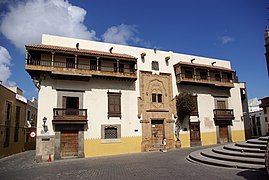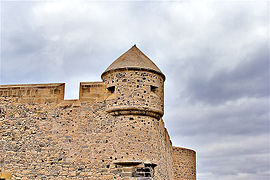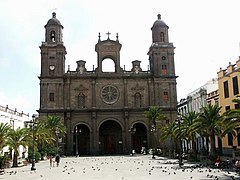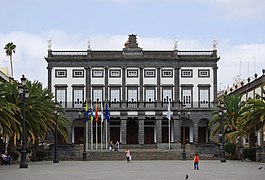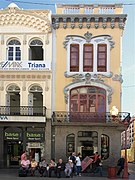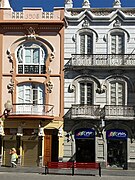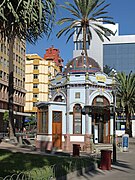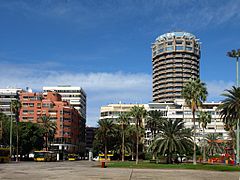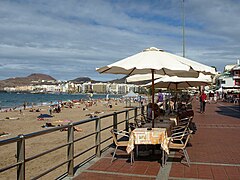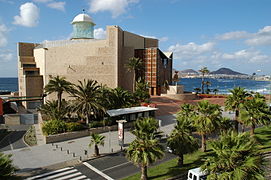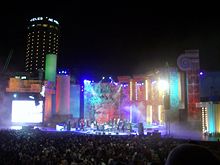Las Palmas de Gran Canaria
| Las Palmas de Gran Canaria | ||
|---|---|---|
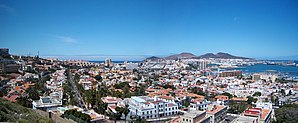 Panorama of Las Palmas
|
||
| coat of arms | Map of the Canary Islands | |

|
|
|
| Basic data | ||
| Autonomous Community : |
|
|
| Province : | Las Palmas | |
| Island: | Gran Canaria | |
| Coordinates | 28 ° 8 ′ N , 15 ° 26 ′ W | |
| Height : | 8 msnm | |
| Area : | 100.55 km² | |
| Residents : | 379,925 (Jan 1, 2019) | |
| Population density : | 3,778.47 inhabitants / km² | |
| Founding: | 1478 | |
| Postal code : | 35001-35020 | |
| Municipality number ( INE ): | 35016 | |
| administration | ||
| Mayor : | Augusto Hidalgo Macario ( PSOE ) | |
| Website : | www.laspalmasgc.es | |
Las Palmas de Gran Canaria , also abbreviated Las Palmas , is a Spanish city on Gran Canaria . With 379,925 inhabitants, it is the largest city in the Canary Islands . It is the capital of the Spanish province of Las Palmas and next to Santa Cruz de Tenerife one of the two capitals of the Canary Islands . The city is significantly shaped by its port, which is one of the largest in the Atlantic . The neighboring communities are Santa Brígida and Telde in the south and Arucas and Teror in the west.
climate
In Las Palmas de Gran Canaria it is often very cloudy. This climatic phenomenon , which the locals refer to as "panza de burro" (donkey belly), has led to tourism shifting from the capital to the south of Gran Canaria and now concentrating almost exclusively on Maspalomas and the Costa Mogán . Nevertheless, a study by the University of Syracuse ( USA ) has named Las Palmas de Gran Canaria as the city with the best climate in the world.
| Las Palmas de Gran Canaria | ||||||||||||||||||||||||||||||||||||||||||||||||
|---|---|---|---|---|---|---|---|---|---|---|---|---|---|---|---|---|---|---|---|---|---|---|---|---|---|---|---|---|---|---|---|---|---|---|---|---|---|---|---|---|---|---|---|---|---|---|---|---|
| Climate diagram | ||||||||||||||||||||||||||||||||||||||||||||||||
| ||||||||||||||||||||||||||||||||||||||||||||||||
|
Average monthly temperatures and rainfall for Las Palmas de Gran Canaria
Source: World Meteorological Organization The climatological data are based on the monthly averages from 1971 to 2000
|
|||||||||||||||||||||||||||||||||||||||||||||||||||||||||||||||||||||||||||||||||||||||||||||||||||||||||
Attractions
Museums and theaters
- The Columbus Museum is housed in the Casa de Colón (named after Cristóbal Colón , Spanish for 'Christopher Columbus'), a magnificent colonial building. It is located in the old town behind the Santa Ana Cathedral. The museum covers the history of the Canary Islands and their relationship with America. It has 13 permanent exhibition rooms, a library and study rooms as well as various rooms for short-term activities. The complex consists of a few houses, one of which was reached by Christopher Columbus during his first trip to America in 1492. The museum is organized according to five thematic areas: America before his discovery, Columbus and his travels, the Canary Islands as a strategic base for exploring the New World, the history and development of the city of Las Palmas and paintings from the 16th to the beginning of the 20th century.
- The " Museo Canario " is located in the historic Vegueta district. Founded in 1879, it is an international partner of the Council for Scientific Research (CSIC). It has a valuable collection of archaeological finds from the Canary Islands. In addition, the museum has a library with over 60,000 copies.
- The “ Casa Museo Pérez Galdós ” is located in the Triana district. It is the birthplace of the writer Benito Pérez Galdós . It includes a large collection of documents, furniture and personal belongings of the writer.
- The " Museo Néstor " is dedicated to the works of the Canarian painter Néstor Martín-Fernández de la Torre . The museum has 10 exhibition rooms and a documentation center with educational elements.
- The science museum "Museo Elder" at Parque Santa Catalina is an innovative, interactive, scientific and technological museum. Exhibition rooms, workshops, interactive modules, large-format films and greenhouse gardens are accessible to visitors on over 4500 m².
- The renowned center for modern art - Centro Atlántico de Arte Moderno - plays an important role in the cultural and artistic life of the Canary Islands and is responsible for the dissemination of the works of art made on the islands. It has permanent and temporary exhibitions ranging from historical avant-garde to modern themes. It is located on Calle Los Balcones de Vegueta and will retain its original facade from the 18th century.
In the southwest of the Triana district is the Teatro Pérez Galdós , the city's most important theater.
In the north of the city, in the harbor district, which lies in the south of the La Isleta peninsula, is the fortress " Castillo de la Luz " from the 16th century , surrounded by rose beds . The building is a listed building, was restored in 1990 and now houses a maritime museum as well as the city's cultural and exhibition rooms. On January 28, 2014, the fort was reopened as a marine museum and exhibition space for art after 13 years of renovation. Since June 2014, works by the local visual artist Martín Chirino have also been exhibited there. The redevelopment is related to a large-scale redesign of the city.
Casa de Colón , Columbus Museum
Teatro Pérez Galdós , theater
Castillo de la Luz , museums
Old town ("Vegueta")
The old town of Las Palmas was placed on the national list of proposals ( tentative list ) for inclusion as UNESCO World Heritage in 2007 .
- In the main square, Plaza Santa Ana , is the five-aisled cathedral from 1497, where the Bishop of the Canary Islands has his seat.
- On the opposite side is the old town hall, a classicist building from 1853.
- Also worth seeing is the Plaza Espíritu Santu on the south side of the town hall, which got its name from the chapel located there . The square is surrounded by buildings of various styles, such as Renaissance , Classicism and Mudejar style .
Triana
To the north of the old town is the Triana district.
- Buildings from around 1900 line the Calle Mayor de Triana, the main shopping street and the pedestrian zone. The houses show typical Spanish architectural elements of this time, including Art Nouveau facades .
- The San Telmo Park is named after the seafarers' chapel of the same name located there. It forms a green oasis with colorful Art Nouveau pavilions.
- The Gabinete Literario, an Art Nouveau building that is used for exhibitions and lectures, is located in Plaza Cairasco.
Santa Catalina
The tourist district of Santa Catalina lies between the port and the beach.
- On the beach promenade , the “Paseo de las Canteras”, the 3.2 km long city beach “Playa de las Canteras” stretches out with bars, terrace cafes and shops.
- Another attraction is the Santa Catalina Park, lined with bars and cafes.
- Since 2003, the 60 meter high residential and commercial building "Torre Woermann" has risen above the city quarter.
- At the north-western exit of the city is the " Auditorio Alfredo Kraus ", built in 1997 , a modern concert hall right by the sea, which is named after the Las Palmas-born tenor Alfredo Kraus .
This area is full of bars and nightclubs near the port.
beaches
The city has four main beaches:
- Las Canteras Beach is the largest among them and is the most visited by city residents and visitors all year round. It is located on the western side of the isthmus of Guanarteme, which connects the La Isleta peninsula in northeast Gran Canaria with the rest of the island.
- Las Alcaravaneras Beach is also on the Guanarteme Strait, but on its eastern side.
- La Laja beach, made of fine, gray sand, is around 1200 m long and 40 m wide. Its moderate waves and currents are no longer dangerous after a dam was built in the 1990s.
- Confital Beach in the southwest of the Isleta Peninsula is a natural extension of Las Canteras Beach. The area that can be used for swimming is around two kilometers.
Regular events
The carnival of Las Palmas ( Spanish Carnaval ) is celebrated every year with great effort between January and February. In 2017 it was declared the Fiesta de Interés Turístico Nacional (loosely translated: 'Festivities of National Tourist Interest').
The international film festival Festival Internacional de Cine Las Palmas de Gran Canaria has been held every year in the Alfredo Kraus Auditorium since 2000 . At the entrance to the concert hall, international artists such as Faye Dunaway , Alain Delon , Catherine Deneuve , Omar Sharif and Mia Farrow , who attended the festival, received a star in the pavement and left their handprint.
The WOMAD (World Of Music, Art & Dance) Festival usually takes place in November each year.
traffic
The historically valuable town center was relieved of traffic at the end of the 20th / beginning of the 21st century. In addition to the tunnel, which connects the formerly only connecting road between south and north, the Avenida Marítima, with the north motorway, a bypass road has been ensuring that through traffic passes Las Palmas de Gran Canaria since 2004 , thus further reducing the load on the city center. The most important highways are the GC-1 to the south (e.g. airport , Maspalomas ) and the GC-2 to the west (to Agaete ).
From the bus stations Santa Catalina and San Telmo there are overland bus connections from the transport company Global to all parts of the island. In addition, the two bus stations are the northern starting points of the planned railway line from Las Palmas to Maspalomas. In addition to ferries to the neighboring islands, Las Palmas de Gran Canaria is also regularly visited by cruise ships. The airport is around 18 km from the city.
From 1890 there was a tram in Las Palmas - El tranvía al Puerto - which was discontinued in 1937 in favor of public city buses ( Guaguas Municipales ).
economy
Las Palmas most important economic factor is the port of Puerto de la Luz , built at the end of the 19th century . In 2008, 860,710 passengers were counted here (including approx. ¼ cruise passengers ) and 20,053,774 tons of cargo were handled. The port is also important as a fish transshipment point and repair port. Between 2011 and 2019, however, the number of ship connections, especially direct connections in container shipping, fell significantly.
Also resident in Las Palmas are:
- Grupo Kalise Menorquina , a manufacturer of all kinds of desserts that exports its goods all over Spain
- Tirma, a coffee roaster that also makes chocolate and chocolate products
- Compañia Cervecera de Canarias (CCC), a brewery founded in 1924 that produces both here and in Tenerife ( Torpical , Dorada ).
Sports
UD Las Palmas has played in the Segunda División since the 2018/19 season and plays its home games at the Estadio de Gran Canaria .
Town twinning
Las Palmas entertains you with following cities twinning :
|
sons and daughters of the town
- Georgiana Houghton (1814-1884), painter
- Benito Pérez Galdós (1843–1920), writer
- Néstor Martín-Fernández de la Torre (1887–1938), painter
- Juan Negrín (1891–1956), doctor and prime minister
- Juan Pulido (1891–1972), singer and actor
- Pedro Suárez (1908–1979), football player
- Walter Behrens (1911–1999), German-Austrian painter and graphic artist
- Colin Cameron Davies (1924–2017), Roman Catholic religious, Bishop of Ngong in Kenya
- Martín Chirino (1925–2019), sculptor
- Manolo Millares (1926–1972), self-taught painter and artist
- Alfredo Kraus (1927–1999), singer
- Rafael Griera i Calderón (1934-2018), Catalan painter
- Luis Millares Sall "Totoyo" (* 1935), musician, founder of modern timple music
- Alberto Romero Rivera (1935–1997), activist against the Roman Catholic Church
- Jerónimo Saavedra Acevedo (* 1936), politician
- Antonio Betancort (1937-2015), football player
- Charles Quiney (1937–2007), film actor
- Ulrike Behrmann von Zerboni (* 1940), German actress
- Juan Manuel Suárez Del Toro Rivero (* 1952), industrial engineer
- Eufemiano Fuentes (* 1955), sports medicine specialist
- José Luis Doreste (* 1956), sailor
- Juan Fernando López Aguilar (* 1961), lawyer, politician (PSOE), Member of the European Parliament, Minister of Justice
- Luis Doreste Blanco (* 1961), sailor
- Domingo Manrique (* 1962), sailor
- Ana Wagener (* 1962), theater and film actress
- Patricia Guerra (* 1965), sailor
- Fernando León (* 1966), sailor
- Javier Bardem (born 1969), actor
- Sven Giegold (* 1969), German politician
- José Antonio Ramos (1969–2008), Timple musician
- Elton Julian (* 1974), American car racing driver and racing team owner
- Alejandro Suárez Martín (* 1974), football player
- Daida and Iballa Ruano Moreno (* 1977), women windsurfers
- Jonathan Sesma González (* 1978), football player
- Yeray Ortega Guarda (* 1979), football player
- Magüi Serna (* 1979), tennis player
- Antonio Guayre (* 1980), football player
- Davinia Rodríguez (* 1980), opera singer (soprano)
- Jorge Larena (* 1981), soccer player
- Ángel López (* 1981), football player
- Rubén Castro Martín (* 1981), football player
- Marta Mangué (* 1983), handball player
- Daniel Sarmiento (* 1983), handball player
- Rafael Cabrera-Bello (* 1984), professional golfer
- Ramón del Castillo (born 1985), singer
- Ione Cabrera (born 1985), football player
- Nacho Casanova (* 1987), football player
- Fabricio Agosto Ramírez (* 1987), football player
- Carla Suárez (* 1988), tennis player
- Vitolo (* 1989), football player
- Roko Peribonio (* 1991), Croatian handball player
- Sofi de la Torre (* 1991), singer and songwriter
- Jesé Rodríguez Ruiz (* 1993), football player
- Philip Köster (* 1994), German windsurfer
Web links
Individual evidence
- ↑ Cifras oficiales de población resultantes de la revisión del Padrón municipal a 1 de enero . Population statistics from the Instituto Nacional de Estadística (population update).
- ^ Iván Suárez: Los Príncipes reabren el Castillo de La Luz entre abucheos. In: eldiario.es. January 28, 2014, accessed December 10, 2018 (Spanish).
- ↑ El Castillo de La Luz abre en 2014 después de trece años cerrado. In: Canarias7.es. (Website) November 1, 2013.
- ↑ El Ayuntamiento informa que la Fundación Martín Chirino abrirá sus puertas en el Castillo de La Luz in junio de 2014. In: Ayuntamiento de Las Palmas de Gran Canaria. (Press release on the website), November 2013.
- ↑ Discover Las Palmas de Gran Canaria . Retrieved September 18, 2014.
- ^ Resolución de 28 de March 2017, de la Secretaría de Estado de Turismo, por la que se concede el título de Fiesta de Interés Turístico Nacional a la fiesta El Carnaval de Las Palmas de Gran Canaria. In: boe.es . March 31, 2017, accessed October 24, 2019 (Spanish).
- ↑ Construction project for the Las Palmas - Maspalomas train connection starts. In: comprendes-grancanaria.de. December 9, 2011, archived from the original on January 19, 2012 ; accessed on April 8, 2018 .
- ↑ Another step for the rail connection between Las Palmas de Gran Canaria and Maspalomas. In: comprendes-grancanaria.de. July 2, 2010, archived from the original on April 29, 2012 ; accessed on April 24, 2019 .
- ↑ Planning for the train project is in full swing. (No longer available online.) In: comprendes-grancanaria.de. Archived from the original on September 23, 2015 ; accessed on May 13, 2019 .
- ↑ Already 18 million euros spent on train project. In: comprendes-grancanaria.de. December 14, 2012, archived from the original on September 23, 2015 ; accessed on November 1, 2019 .
- ↑ Silvia Fernández: La pérdida de conectividad lastra a La Luz en el 'ranking' mundial. In: Canarias7, October 21, 2019, p. 19.
- ↑ Hermanamientus. In: laspalmasgc.es. Archived from the original on November 25, 2018 ; Retrieved on November 25, 2018 (The content of the original page is not persistent. The information in the article is based on the archived version.).

